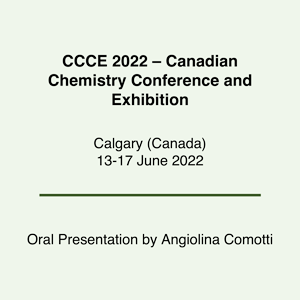Calgary (Canada), 13-17 June 2022, Oral Presentation by Angiolina Comotti
Title: “Benchmark Rotor Dynamics and Light-driven Motors Engineered in 3D Porous Architectures”
Authors: A. Comotti, S. Bracco, J. Perego, C. X. Bezuidenhout, G. Prando, S. Piva and P. Sozzani
Abstract
Rotors, motors and switches in the solid state find a favorable playground in porous materials, especially in Metal Organic Frameworks (MOFs), thanks to their large free volume, which allows for fast dynamics. We have realized a fast molecular rotor in the solid state whose rotation speed approaches that of unhindered rotations in organic moieties even at very low temperatures (2 K) [1,2]. The three-fold bipyramidal symmetry of the rotator conflicts with the four-fold symmetry of the struts within the cubic crystal cell of the zinc metal–organic framework, frustrating the formation of stable conformations. This allows for the hyperfast rotation of the bicyclic units persistent for several continuous turns, with an energy barrier of 6.2 cal mol−1 and a high frequency even at very low temperatures (1010 Hz below 2 K). Geared molecular rotors with negligible energy-requirements in MOFs enabled fast yet controllable and correlated rotary motion[3]. A MOF architecture was capable of supporting fast motional regimes (107 Hz), even at extremely cold temperatures, of two distinct and hypermobile rotors arranged in pillar-and-layer 3D arrays. The rotors explored multiple configurations of conrotary and disrotary relationships, switched on and off by thermal energy, an unprecedented cascade mechanism modulated by distinct energy barriers as supported by 2H solid-echo, 1H T1 relaxation NMR and DFT modeling. Chemical stimuli such as the use of CO2 diffused through the open pores changed dramatically the global rotation mechanism and rotor speed. Furthermore, motors were inserted into porous frameworks and metal-organic frameworks wherein two distinct linkers with complementary light absorption-emission properties were integrated into the same material. Unidirectional motion was achieved by exposure to sun-light of the solid particles, which thus behave as autonomous nanodevices.[4] The visible-light-driven rotation of an overcrowded alkene-based molecular motor strut in a dual-function metal−organic framework (MOF) was realized by the use of two types of functional linkers. A palladium−porphyrin photosensitizer and a bispyridine derived molecular motor allowed to construct the framework capable of harvesting low-energy green light to power the rotary motion. Visible light-driven rotation of the molecular motor was proved to be in the solid state at rates similar to those observed in solution.[5]The visible-light-driven rotation of an overcrowded alkene-based molecular motor strut in a dual-function metal−organic framework (MOF) was realized by the use of two types of functional linkers. Visible light-driven rotation of the molecular motor was proved to be in the solid state at rates similar to those observed in solution.[5] [1] A. Comotti, P. Sozzani, S. Bracco, J. Perego, C. Bezuidenhout, G. Prando, P. Carretta Nature Chem. 2020, 12, 845. [2] G. Prando, P. Carretta, A. Comotti, P. Sozzani, S. Bracco, J. Perego, C. Bezuidenhout, Nanoletters 2020, 20, 7613. [3] A. Comotti, P. Sozzani, S. Bracco, J. Perego, C. Bezuidenhout, G. Prando, L. Marchio’, P. Carretta J. Am. Chem. Soc. 2021, 143, 13082. [4] F. Castiglioni, W. Danowski, J. Perego, P. Sozzani, S. Bracco, S. J. Wezenberg, A. Comotti, B. L. Feringa Nature Chem. 2020, 12, 595. [5] W. Danowski, F. Castiglioni, S. Bracco, S. J. Wezenberg, A. Comotti, B. L. Feringa et al J. Am. Chem. Soc. 2020, 142, 9048.

